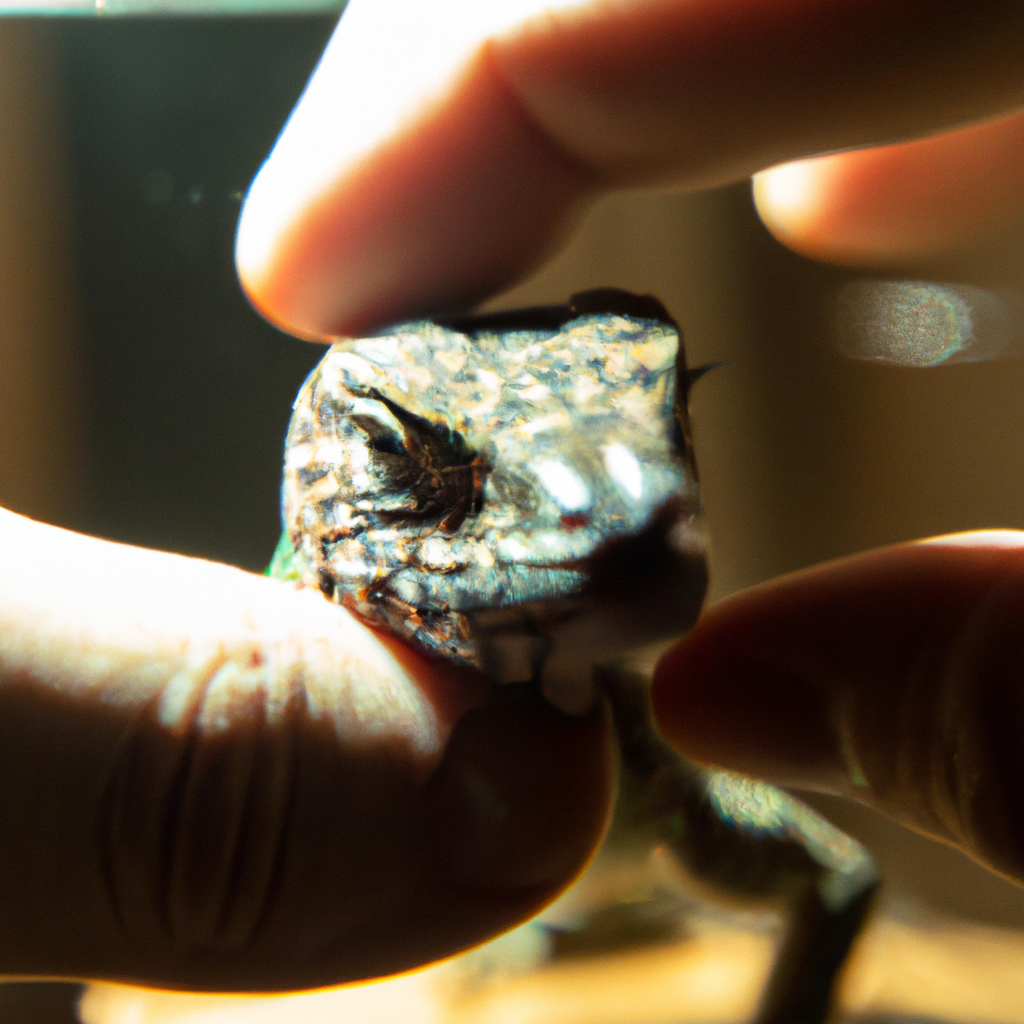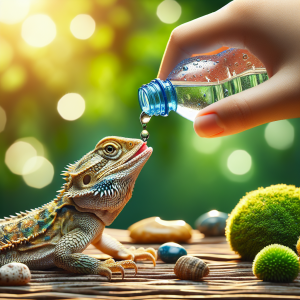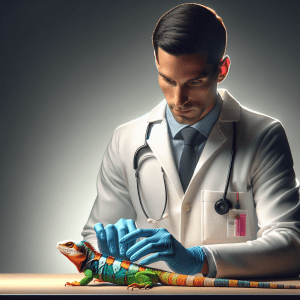Introduction to Lizard Care and Husbandry
Caring for a lizard as a pet can be a rewarding and fulfilling experience. However, it is important to understand that lizards have specific needs and requirements that must be met in order for them to thrive in captivity. This introduction will provide an overview of lizard care and husbandry, giving you a solid foundation to build upon as you embark on your journey as a lizard owner.
First and foremost, it is crucial to research and understand the specific species of lizard you are interested in keeping as a pet. Different species have different care requirements, so it is important to choose a lizard that aligns with your lifestyle and capabilities as a pet owner. Some lizards, such as bearded dragons or leopard geckos, are more commonly kept as pets and have readily available care information. Others, like chameleons or iguanas, may require more specialized care and should only be considered by experienced reptile keepers.
Once you have chosen the right lizard species for you, it is important to create a suitable habitat for your pet. This includes providing the appropriate enclosure size, temperature and humidity levels, lighting, and substrate. The enclosure should mimic the lizard’s natural habitat as closely as possible to ensure their comfort and well-being.
Feeding and nutrition are also key aspects of lizard care. Different lizard species have different dietary requirements, so it is important to research and provide a balanced diet that includes a variety of live insects, fruits, vegetables, and occasionally small vertebrates. It is important to ensure that the food is appropriately sized for your lizard and that any prey items are gut-loaded and dusted with calcium and vitamin supplements.
Handling techniques for lizards should be gentle and cautious, as they can be easily stressed or injured. It is important to allow your lizard to become accustomed to your presence and to handle them with care and confidence. Regular handling can help to build trust and strengthen the bond between you and your pet.
In conclusion, this introduction provides a brief overview of lizard care and husbandry. It is important to research and understand the specific needs of your chosen lizard species in order to provide them with a suitable habitat, proper nutrition, and appropriate handling. By mastering the basics of lizard care, you can ensure the health and well-being of your pet and enjoy a rewarding and fulfilling relationship with your lizard companion.Creating a Suitable Habitat for Your Lizard
When it comes to caring for lizards, providing a suitable habitat is crucial for their overall health and well-being. Lizards are ectothermic animals, meaning they rely on external sources of heat to regulate their body temperature. Therefore, it is essential to create a habitat that allows them to thermoregulate effectively.
First and foremost, you will need to select an appropriate enclosure for your lizard. The size of the enclosure should be large enough to accommodate the specific species of lizard you have, allowing them to move around comfortably. It should also have a secure lid or cover to prevent any escapes.
Next, you will need to set up a proper heating and lighting system. Lizards require a temperature gradient within their enclosure, with a warm basking spot and a cooler area. This can be achieved by using heat lamps or heating pads, along with a thermostat to regulate the temperature. Additionally, UVB lighting is essential for lizards as it helps them synthesize vitamin D3, which is crucial for calcium metabolism.
The substrate or bedding in the enclosure should be chosen carefully, taking into consideration the specific needs of your lizard species. Some lizards prefer a more arid environment, while others require a more humid substrate. It is important to research the natural habitat of your lizard species to determine the most suitable substrate.
In addition to the heating and lighting, you will need to provide hiding spots and climbing structures for your lizard. These can be in the form of rocks, branches, or artificial decorations. These hiding spots not only provide a sense of security for your lizard but also allow them to exhibit their natural behaviors.
Lastly, maintaining proper hygiene in the enclosure is essential. Regularly clean and disinfect the enclosure to prevent the buildup of bacteria or parasites. Also, provide a shallow dish of clean water for your lizard to drink from and soak in.
By creating a suitable habitat for your lizard, you are ensuring their comfort and well-being. This will contribute to their overall health and happiness as a pet. Remember to research the specific needs of your lizard species and consult with a reptile expert if needed to provide the best care possible.
Feeding and Nutrition Tips for Lizards
Proper feeding and nutrition are essential for the health and well-being of your pet lizard. Different species of lizards have different dietary requirements, so it is important to research and understand the specific needs of your lizard species.
One of the most important aspects of feeding your lizard is providing a balanced diet. In the wild, lizards have a varied diet that includes insects, fruits, vegetables, and even small vertebrates. As a pet owner, it is your responsibility to replicate this varied diet as closely as possible.
For insectivorous lizards, such as bearded dragons or leopard geckos, a diet consisting mainly of insects is necessary. Crickets, mealworms, and waxworms are commonly fed to these lizards. It is important to gut-load the insects before feeding them to your lizard. Gut-loading involves feeding the insects with nutritious foods, such as fruits and vegetables, to ensure that your lizard receives the necessary nutrients.
Vegetables and fruits should also be included in the diet of herbivorous lizards, such as iguanas or uromastyx. Leafy greens, such as kale, collard greens, and dandelion greens, are excellent choices. Fruits like berries, melons, and papaya can be offered as occasional treats.
Supplementation is another important aspect of lizard nutrition. Many lizards require additional vitamins and minerals to maintain optimal health. Calcium and vitamin D3 are particularly important for proper bone development and preventing metabolic bone disease. These supplements can be dusted onto the insects or mixed into the lizard’s food.
It is crucial to monitor your lizard’s weight and adjust its feeding schedule accordingly. Overfeeding can lead to obesity and other health issues, while underfeeding can result in malnutrition. It is recommended to feed your lizard small, frequent meals rather than one large meal.
Lastly, always provide fresh, clean water for your lizard. Some lizards may prefer to drink from a shallow dish, while others may prefer to lick water droplets off leaves or other surfaces. Make sure to clean the water dish regularly to prevent the growth of bacteria.
By following these feeding and nutrition tips, you can ensure that your pet lizard receives the proper nutrients it needs to thrive and live a healthy life. Remember to consult with a reptile veterinarian or do thorough research on your specific lizard species to provide the best care possible.
Handling Techniques for Lizards
Proper handling techniques are essential when it comes to caring for lizards as pets. Lizards can be delicate creatures, and mishandling them can cause stress, injury, or even death. Therefore, it is crucial to learn the correct way to handle your lizard to ensure its safety and well-being.
First and foremost, it is important to approach your lizard calmly and slowly. Sudden movements or loud noises can startle them and cause them to become defensive. Approach from the side rather than from above, as this can mimic a predator and trigger a fear response.
When picking up your lizard, it is best to support its body with both hands. Gently scoop it up from underneath, supporting its belly and hind legs. Avoid grabbing or squeezing the lizard too tightly, as this can cause discomfort or injury. It is also important to avoid grabbing the tail, as some lizard species can drop their tails as a defense mechanism.
Once you have your lizard in your hands, it is important to handle it gently and with care. Avoid excessive movement or jostling, as this can cause stress. Allow your lizard to move at its own pace and avoid restraining it too tightly. Some lizards may enjoy being held and may even tolerate gentle petting, while others may prefer to be left alone. It is important to observe your lizard’s body language and behavior to determine its comfort level.
When it comes to handling venomous or aggressive lizard species, it is best to leave it to the experts. These lizards require specialized handling techniques and should only be handled by experienced individuals who have the necessary knowledge and skills.
In conclusion, proper handling techniques are crucial for the well-being of your pet lizard. Approach your lizard calmly and slowly, support its body with both hands, and avoid grabbing or squeezing too tightly. Handle your lizard gently and observe its behavior to determine its comfort level. Remember, each lizard is unique, so it is important to learn about the specific needs and preferences of your particular species. By following these guidelines, you can ensure a positive and safe handling experience for both you and your lizard.
Health and Hygiene Practices for Lizards
Proper health and hygiene practices are essential for ensuring the well-being of your pet lizard. Here are some important tips to keep in mind:
1. Regular Veterinary Check-ups: Just like any other pet, lizards also require regular veterinary check-ups. Find a reptile veterinarian who specializes in lizard care and schedule routine visits to ensure your lizard’s overall health. These check-ups can help detect any potential health issues early on and prevent them from escalating.
2. Clean and Sterilize the Habitat: Maintaining a clean and hygienic habitat is crucial for your lizard’s health. Regularly clean the enclosure, removing any waste, uneaten food, and shedding skin. Use a reptile-safe disinfectant to sterilize the habitat, ensuring that there are no harmful bacteria or parasites present.
3. Provide Clean Water: Lizards need access to clean and fresh water at all times. Ensure that the water dish is cleaned and refilled daily to prevent the growth of bacteria. Some lizard species may also benefit from occasional misting to maintain proper hydration levels.
4. Monitor Temperature and Humidity: Lizards are ectothermic, meaning they rely on external heat sources to regulate their body temperature. It is crucial to provide a temperature gradient within the enclosure, allowing your lizard to move between warmer and cooler areas as needed. Additionally, maintaining the appropriate humidity level is essential for their respiratory health.
5. Preventative Parasite Control: Parasites can pose a significant threat to your lizard’s health. Consult with your veterinarian about preventative measures, such as regular deworming, to keep your lizard free from internal parasites. Additionally, regularly inspect your lizard for external parasites, such as mites or ticks, and take appropriate action if necessary.
6. Avoid Overhandling: While handling your lizard can be a rewarding experience, it is important to avoid excessive handling, as it can cause stress and potentially harm your pet. Always wash your hands before and after handling your lizard to prevent the transmission of any bacteria or diseases.
By following these health and hygiene practices, you can ensure that your pet lizard remains healthy and happy. Remember to always do thorough research on the specific needs of your lizard species and consult with a reptile veterinarian for personalized advice and guidance.
Understanding the Needs and Behaviors of Different Lizard Species
Understanding the needs and behaviors of different lizard species is crucial for providing proper care and husbandry. Lizards come in a wide variety of species, each with its own unique characteristics and requirements. By familiarizing yourself with the specific needs of the lizard species you are caring for, you can ensure that their habitat, diet, and overall care are tailored to their specific needs.
One important aspect to consider when understanding the needs of different lizard species is their natural habitat. Lizards come from various environments, such as deserts, rainforests, or grasslands. It is essential to replicate their natural habitat as closely as possible in captivity. This includes providing the appropriate temperature, humidity, lighting, and substrate for their enclosure. Some lizards may require a basking spot with a specific temperature range, while others may need a humid hide or access to water for soaking.
Another important factor to consider is the diet and nutrition of different lizard species. Lizards have different dietary requirements based on their natural feeding habits. Some lizards are herbivores and require a diet rich in leafy greens and vegetables, while others are insectivores and need a diet consisting of live insects. It is important to research and provide a balanced diet that meets the nutritional needs of your specific lizard species.
Understanding the behavior of different lizard species is also crucial for their well-being. Some lizards are more social and may benefit from having a companion, while others are solitary and prefer to be housed alone. Additionally, knowing their natural behaviors, such as basking, climbing, or burrowing, can help you provide an enriched environment that allows them to engage in their natural behaviors.
By understanding the needs and behaviors of different lizard species, you can ensure that you are providing the best possible care for your pet. This knowledge will help you create a suitable habitat, provide the right diet, and cater to their specific needs. It is important to continuously educate yourself and stay updated on the latest research and information regarding lizard care to ensure the well-being and happiness of your pet lizard.
Breeding Lizards: Tips and Considerations
Breeding lizards can be a rewarding and fascinating experience for reptile enthusiasts. However, it is important to understand the proper techniques and considerations involved in lizard breeding to ensure the health and well-being of both the parent lizards and their offspring. Here are some tips and considerations for successfully breeding lizards.
1. Age and Health: Before attempting to breed lizards, it is crucial to ensure that both the male and female lizards are in good health and of appropriate breeding age. Lizards typically reach sexual maturity at different ages depending on the species, so it is important to research and understand the specific requirements for the particular species you are working with.
2. Pairing: When selecting lizards for breeding, it is important to pair compatible individuals. This means choosing lizards of the same species and similar size. It is also important to consider the temperament of the lizards, as aggressive or dominant individuals may not be suitable for breeding.
3. Breeding Season: Many lizard species have specific breeding seasons, during which they are more likely to mate successfully. Research the natural breeding season for your chosen species and try to replicate the environmental conditions, such as temperature and lighting, to encourage breeding behavior.
4. Nesting and Egg Laying: Provide a suitable nesting area for the female lizard to lay her eggs. This can be a shallow container filled with a suitable substrate, such as sand or soil. Ensure that the nesting area is kept at the appropriate temperature and humidity levels to promote successful egg development.
5. Incubation: Once the eggs are laid, they will need to be incubated at the correct temperature and humidity levels to ensure proper development. Research the specific requirements for your chosen species and invest in a reliable incubator or create a DIY incubation setup.
6. Care for Hatchlings: Once the eggs hatch, it is important to provide appropriate care for the hatchlings. This may include providing a suitable enclosure, proper nutrition, and monitoring their health and growth.
Breeding lizards can be a complex process, and it is important to do thorough research and seek guidance from experienced breeders or herpetologists. By following these tips and considerations, you can increase your chances of successfully breeding lizards and contribute to the conservation and understanding of these fascinating creatures.
Selecting the Right Lizard Species as a Pet
When it comes to selecting the right lizard species as a pet, there are several factors to consider. Each lizard species has its own unique needs and requirements, so it’s important to choose one that aligns with your lifestyle and capabilities as a pet owner.
First and foremost, you should research and understand the specific care requirements of different lizard species. Some lizards, such as bearded dragons and leopard geckos, are popular choices for beginners due to their relatively low maintenance needs. They require a suitable habitat with proper lighting, heating, and humidity levels, as well as a balanced diet consisting of insects and vegetables.
On the other hand, more advanced lizard species like chameleons and iguanas require more specialized care. Chameleons, for example, need a tall and well-ventilated enclosure with plenty of live plants and branches for climbing. They also have specific temperature and humidity requirements that need to be carefully monitored.
Another important consideration is the size and lifespan of the lizard species. Some lizards, like anoles and skinks, are relatively small and have shorter lifespans, while others, like monitor lizards and tegus, can grow quite large and live for several decades. It’s crucial to ensure that you have enough space and resources to accommodate the size and lifespan of the lizard species you choose.
Additionally, you should consider your level of experience and commitment as a pet owner. Some lizard species, like the green anole, are more forgiving and can tolerate minor mistakes in care, while others, like the veiled chameleon, are more sensitive and require a higher level of expertise. It’s important to be honest with yourself about your abilities and willingness to provide the necessary care and attention to your chosen lizard species.
In conclusion, selecting the right lizard species as a pet requires careful consideration of their specific care requirements, size, lifespan, and your own capabilities as a pet owner. By doing thorough research and understanding the needs of different lizard species, you can ensure that you provide the best possible care and create a fulfilling and enriching environment for your pet lizard.
Troubleshooting Common Issues in Lizard Care
Taking care of lizards as pets can be a rewarding experience, but it is not without its challenges. Like any other pet, lizards can face various issues that require troubleshooting and problem-solving. In this section, we will discuss some common issues that lizard owners may encounter and provide tips on how to address them.
One common issue in lizard care is improper shedding. Lizards shed their skin periodically, and if the shedding process is not smooth, it can lead to complications. If you notice that your lizard is having difficulty shedding, you can help by providing a humid environment. This can be achieved by misting the enclosure with water or placing a shallow dish of water for the lizard to soak in. Additionally, you can gently assist in removing any stuck shed by using a damp cloth or your fingers.
Another issue that lizard owners may face is a loss of appetite. If your lizard is not eating, it could be due to various reasons such as stress, illness, or improper diet. It is important to monitor your lizard’s eating habits and consult a veterinarian if the issue persists. In the meantime, you can try offering a variety of food options and ensuring that the temperature and lighting in the enclosure are appropriate.
Lizards are also prone to certain health issues, such as metabolic bone disease or respiratory infections. These conditions can be caused by improper diet, inadequate UVB lighting, or poor hygiene. Regular veterinary check-ups and proper husbandry practices can help prevent and address these health issues.
Additionally, behavioral issues such as aggression or excessive hiding can arise in lizards. These behaviors can be a result of stress, inadequate environmental enrichment, or improper handling. It is important to provide a suitable and stimulating environment for your lizard, as well as handle them gently and appropriately.
In conclusion, troubleshooting common issues in lizard care is an essential part of being a responsible lizard owner. By being observant, proactive, and seeking professional advice when needed, you can ensure the well-being and happiness of your pet lizard.
Conclusion: Mastering Lizard Care in 2024
In conclusion, mastering lizard care and husbandry in 2024 requires a combination of knowledge, dedication, and attention to detail. By following the expert tips and guidelines provided in this article, you can ensure that your pet lizard thrives in a suitable habitat and receives proper nutrition and care.
Throughout this guide, we have emphasized the importance of creating a suitable habitat for your lizard. This includes providing the right temperature, humidity, lighting, and substrate. By mimicking their natural environment, you can help your lizard feel comfortable and secure.
Feeding and nutrition are also crucial aspects of lizard care. Different lizard species have different dietary requirements, so it is important to research and provide a balanced diet that meets their specific needs. This may include a combination of live insects, fruits, vegetables, and commercially available reptile food.
Handling techniques for lizards should be done with care and caution. Lizards can be delicate creatures, and improper handling can cause stress or injury. It is important to learn the proper techniques and to handle your lizard gently and confidently.
Maintaining the health and hygiene of your lizard is essential for their overall well-being. Regular veterinary check-ups, proper hygiene practices, and monitoring for any signs of illness or disease are all important aspects of lizard care.
Understanding the needs and behaviors of different lizard species is crucial for providing appropriate care. Each species has its own unique characteristics and requirements, so it is important to research and understand the specific needs of your chosen lizard species.
Breeding lizards can be a rewarding but challenging endeavor. It requires careful planning, proper housing, and knowledge of the breeding process. If you are considering breeding lizards, it is important to educate yourself and seek guidance from experienced breeders.
When selecting the right lizard species as a pet, it is important to consider factors such as size, temperament, and level of care required. Researching different species and consulting with experts can help you make an informed decision.
Finally, troubleshooting common issues in lizard care is an important skill to develop. From shedding problems to behavioral issues, being able to identify and address common challenges will help ensure the health and well-being of your lizard.
In conclusion, by following the expert tips and guidelines provided in this article, you can become a master of lizard care and husbandry in 2024. With proper knowledge and dedication, you can provide your pet lizard with a happy and healthy life.




